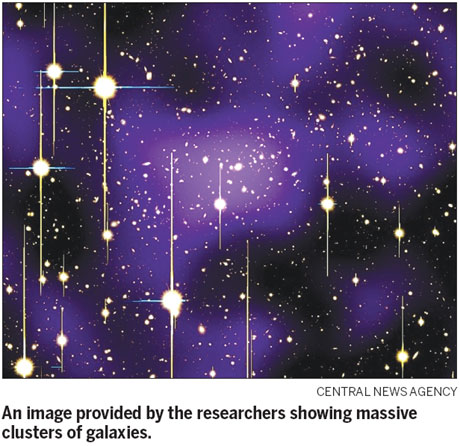Astrophysicists unveil shape of dark matter's distribution
Updated: 2010-04-30 07:17
(HK Edition)
|
|||||||

An international team of astrophysicists including Japanese scholars working at Academia Sinica have discovered clear, direct evidence about the shape of the distribution of so-called dark matter in the universe. The disclosure came in a press release from Taiwan's top research institute Thursday.
Dark matter is an enigma of the cosmos that has fascinated astrophysicists for decades.
The concept of dark matter originally was advanced as a hypothesis, to account for discrepancies found between the mass of galaxies, clusters of galaxies and the mass of the entire universe derived from scientific research.
As dark matter is invisible and no "dark matter particle" has been discovered, its existence is only inferred based on the gravitational effect on other visible celestial matter or on theoretical models, the scientists said.
Recently, astrophysicists from Japan and Taiwan, including Postdoctoral Fellow Nobuhiro Okabe from the Institute of Astronomy and Astrophysics at Academia Sinica (ASIAA), have found evidence that dark matter is distributed in a giant ellipsoid in massive clusters of galaxies. The finding confirms a major prediction in the prevailing theory about dark matter.
The team observed the clusters of galaxies using the Subaru Telescope's Prime Focus Camera (Suprime-Cam). Observations with Suprime-Cam yielded wide-field images of massive clusters of galaxies - typically located 3 billion light years from Earth. The team examined these distant galaxies to measure and analyze dark matter distribution, the institute said in its press statement.
From their analysis of the images, the team obtained evidence that the distribution of dark matter in the clusters has, on average, an extremely flattened ellipsoid rather than a simple spherical shape.
The degree of the flattening was quite large, corresponding to a ratio of 2:1 in terms of the ratio of the major to minor axes of the ellipsoid.
The team's article, entitled Direct measurement of dark matter halo ellipticity from two-dimensional lensing shear maps of 25 massive clusters, was published online April 23 in Monthly Notices of the Royal Astronomical Society, a leading astrophysics journal.
China Daily/CNA
(HK Edition 04/30/2010 page8)